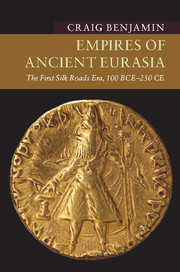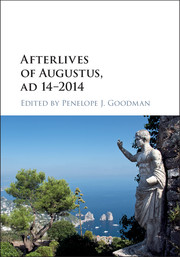Refine search
Actions for selected content:
23990 results in Ancient history
2 - The Relations between China and the Steppe
- from Part I - Historical Thresholds
-
-
- Book:
- Empires and Exchanges in Eurasian Late Antiquity
- Published online:
- 13 April 2018
- Print publication:
- 26 April 2018, pp 35-53
-
- Chapter
- Export citation
Acknowledgements
-
- Book:
- Afterlives of Augustus, AD 14–2014
- Published online:
- 19 April 2018
- Print publication:
- 26 April 2018, pp xiii-xiv
-
- Chapter
- Export citation
5 - The First Emperor?
-
-
- Book:
- Afterlives of Augustus, AD 14–2014
- Published online:
- 19 April 2018
- Print publication:
- 26 April 2018, pp 74-86
-
- Chapter
- Export citation
Contributors
-
- Book:
- Afterlives of Augustus, AD 14–2014
- Published online:
- 19 April 2018
- Print publication:
- 26 April 2018, pp xi-xii
-
- Chapter
- Export citation
Index
-
- Book:
- Afterlives of Augustus, AD 14–2014
- Published online:
- 19 April 2018
- Print publication:
- 26 April 2018, pp 410-418
-
- Chapter
- Export citation
11 - Chinese and Inner Asian Perspectives on the History of the Northern Dynasties (386–589) in Chinese Historiography
- from Part II - Movements, Contacts, and Exchanges
-
-
- Book:
- Empires and Exchanges in Eurasian Late Antiquity
- Published online:
- 13 April 2018
- Print publication:
- 26 April 2018, pp 166-175
-
- Chapter
- Export citation
7 - The Synthesis of the Tang Dynasty
- from Part I - Historical Thresholds
-
-
- Book:
- Empires and Exchanges in Eurasian Late Antiquity
- Published online:
- 13 April 2018
- Print publication:
- 26 April 2018, pp 108-122
-
- Chapter
- Export citation
Introduction
-
-
- Book:
- Empires and Exchanges in Eurasian Late Antiquity
- Published online:
- 13 April 2018
- Print publication:
- 26 April 2018, pp 1-16
-
- Chapter
-
- You have access
- HTML
- Export citation
10 - Augustus as Visionary
-
-
- Book:
- Afterlives of Augustus, AD 14–2014
- Published online:
- 19 April 2018
- Print publication:
- 26 April 2018, pp 152-177
-
- Chapter
- Export citation
6 - Julian Augustus on Augustus
-
-
- Book:
- Afterlives of Augustus, AD 14–2014
- Published online:
- 19 April 2018
- Print publication:
- 26 April 2018, pp 87-102
-
- Chapter
- Export citation

Empires of Ancient Eurasia
- The First Silk Roads Era, 100 BCE – 250 CE
-
- Published online:
- 20 April 2018
- Print publication:
- 03 May 2018

Afterlives of Augustus, AD 14–2014
-
- Published online:
- 19 April 2018
- Print publication:
- 26 April 2018
Acknowledgments
-
- Book:
- The Journey of Christianity to India in Late Antiquity
- Published online:
- 03 May 2018
- Print publication:
- 19 April 2018, pp xii-xiv
-
- Chapter
- Export citation
Contents
-
- Book:
- The Journey of Christianity to India in Late Antiquity
- Published online:
- 03 May 2018
- Print publication:
- 19 April 2018, pp v-vi
-
- Chapter
- Export citation
Preface
-
- Book:
- The Journey of Christianity to India in Late Antiquity
- Published online:
- 03 May 2018
- Print publication:
- 19 April 2018, pp ix-xi
-
- Chapter
- Export citation
Part II - Christianity, Networks, and the Red Sea
-
- Book:
- The Journey of Christianity to India in Late Antiquity
- Published online:
- 03 May 2018
- Print publication:
- 19 April 2018, pp 67-136
-
- Chapter
- Export citation
Maps
-
- Book:
- The Journey of Christianity to India in Late Antiquity
- Published online:
- 03 May 2018
- Print publication:
- 19 April 2018, pp vii-viii
-
- Chapter
- Export citation
Part III - Christianity, Networks, and the Middle East
-
- Book:
- The Journey of Christianity to India in Late Antiquity
- Published online:
- 03 May 2018
- Print publication:
- 19 April 2018, pp 137-232
-
- Chapter
- Export citation
Chapter 2 - Early Christianity and Its Many Indias
- from Part II - Christianity, Networks, and the Red Sea
-
- Book:
- The Journey of Christianity to India in Late Antiquity
- Published online:
- 03 May 2018
- Print publication:
- 19 April 2018, pp 69-93
-
- Chapter
- Export citation
Introduction
-
- Book:
- The Journey of Christianity to India in Late Antiquity
- Published online:
- 03 May 2018
- Print publication:
- 19 April 2018, pp 1-24
-
- Chapter
- Export citation
